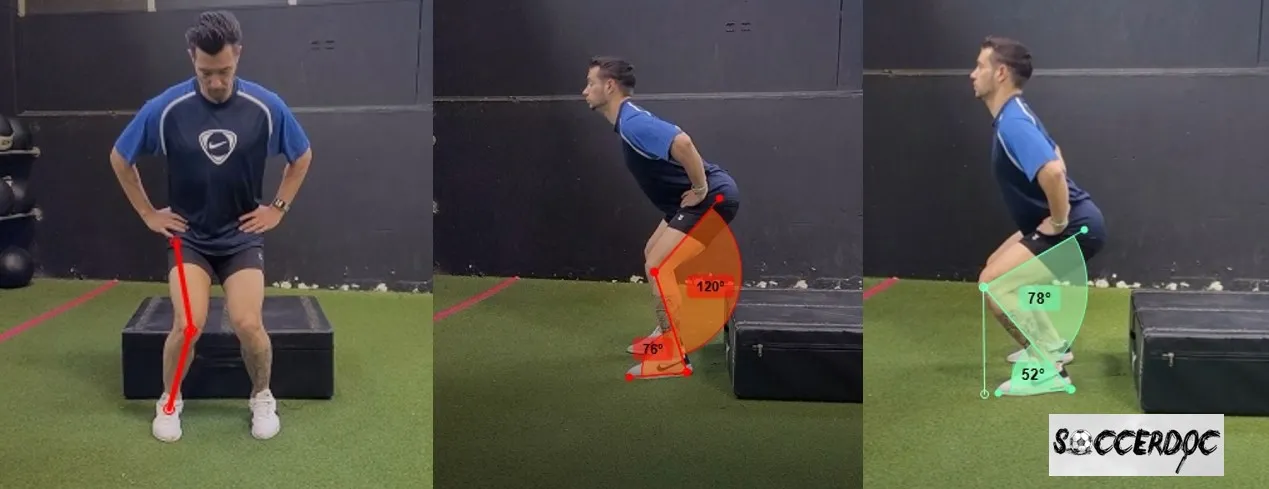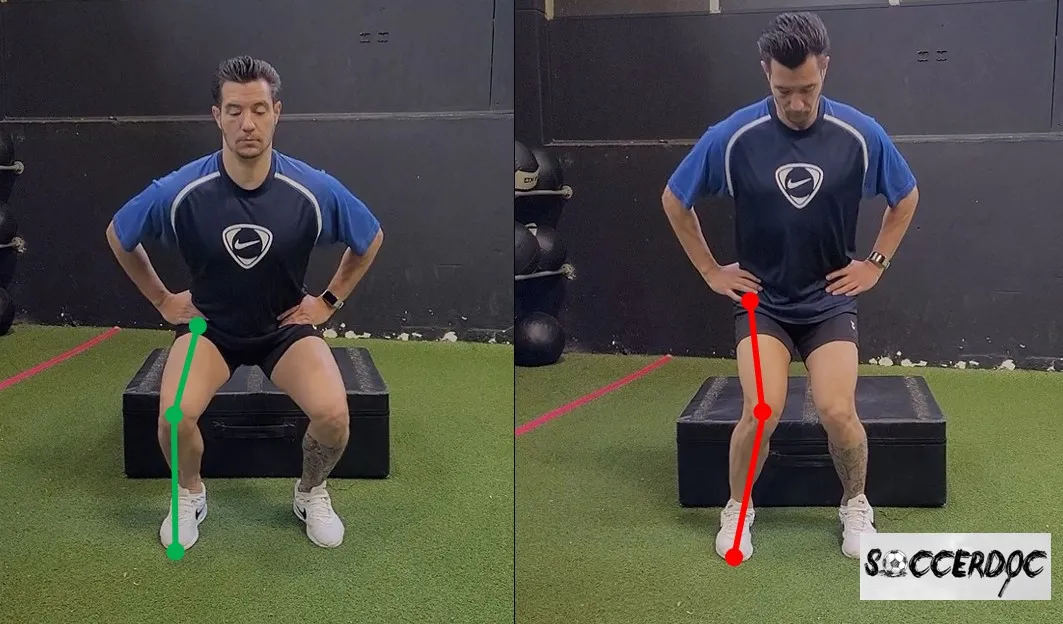Ankle mobility and landing mechanics
VOETBAL MEDISCH SYMPOSIUM 2020
DE BEHANDELING VAN VOETBALBLESSURES
PRAKTISCHE WETENSCHAP
OP DE KNVB CAMPUS IN ZEIST VINDT KOMEND JAAR OPNIEUW HET VOETBALMEDISCH SYMPOSIUM PLAATS.
HET SYMPOSIUM IS DÉ PLEK OM COLLEGA’S BINNEN HET VOETBALMEDISCHE DOMEIN TE ONTMOETEN OF KENNIS OP TE DOEN VAN GERENOMMEERDE EXPERTS. EN DIE NIEUWSTE INNOVATIES TE ZIEN OP HET GEBIED VAN VOETBALMEDISCHE EN FYSIEKE PRESTATIES.
NA VORIG JAAR DE DIAGNOSTIEK VAN VOETBALBLESSURES BELICHT TE HEBBEN, ROLT DE BAL DIT JAAR VERDER NAAR DE BEHANDELING VAN VOETBALBLESSURES. HET INHOUDELIJKE PROGRAMMA BIEDT OPNIEUW SPREKERS DIE ZICH ONDERSCHEIDEN IN ZOWEL DE DAGELIJKSE ZORG VOOR DE VOETBALLERS ALS OP WETENSCHAPPELIJK GEBIED.
VOETBAL MEDISCHE WORKSHOP 2020
(VELD)REVALIDATIE NA EEN VOETBALBLESSURE
OP 4 MAART ZAL ER WEDEROM EEN WORKSHOP PLAATS VINDEN BIJ HET KNVB VOETBAL MEDISCH CENTRUM.
OOK DIT JAAR BELOOFD HET EEN OCHTENDVULLEND PROGRAMMA TE ZIJN WAAR VOORNAMELIJK (SPORT)FYSIOTHERAPEUTEN HUN KENNIS MEE KUNNEN UITBREIDEN.
TIJDENS DE WORKSHOP ZAL MATT TABERNER ZIJN KENNIS EN EXPERTICE MET DE DEELNEMERS GAAN DELEN. MATT TABERNER IS EEN ERVAREN CLINICUS DIE AL JAREN EINDVERANTWOORDELIJK IS VOOR DE REVALIDATIE VAN TOPVOETBALLERS IN DE PREMIER LEAGUE. ZIJN FOCUS LIGT VOORNAMELIJK OP FYSIEKE ONTWIKKELING EN PRESTATIES. TEVENS IS HIJ DE ONTWIKKELAAR VAN HET ‘CONTROL-CHAOS CONTINUUM’.
DIT FRAMEWORK, WELKE VIJF FASES BESCHRIJFT HOE DE VELDREVALIDATIE NA EEN VOETBALBLESSURE OPGEBOUWD KAN WORDEN, STAAT CENTRAAL BINNEN DE WORKSHOP. DE THEORETISCHE ACHTERGROND,
DE TOEPASSING EN HET PRAKTISCHE ASPECT ZULLEN ALLEN AAN BOD KOMEN TIJDENS DE WORKSHOP.
reviews

Nick van der Horst
Meet the soccerdoc
Nick van der Horst behaalde zijn diploma fysiotherapie in 2007 aan de Hogeschool Utrecht. Hij werkte 10 jaar lang als sportfysiotherapeut/echografist/docent bij het Academie Instituut te Utrecht. Daarna heeft hij de overstap gemaakt naar waar zijn hart ligt, het professionele voetbal. Hij heeft twee jaar als sportfysiotherapeut en hoofd van de medische staf bij Go Ahead Eagles in Deventer gewerkt. Momenteel is is Nick werkzaam bij de KNVB. Zijn onderzoeks-activiteiten zijn gefocust op de voetbal-medische zorg. In 2017 behaalde hij zijn doctoraal na het verdedigen van zijn proefschrift ‘Prevention of hamstring injuries in male soccer’.

Blogger: Raúl Gómez
Football is a sport with a high incidence of knee injuries. Among them, the anterior cruciate ligament (ACL) rupture occurs frequently. ACL injury can lead to significant time off the field for players as they undergo months of rehabilitation and training before being cleared to compete again. Several risk factors have been associated with ACL tears, with a particular emphasis on aspects related to thigh muscle strength, hip and trunk stability, and the player’s ability to stabilise their lower limb during movements such as landings and changes of direction. However, ankle dorsiflexion limitations are often overlooked as a risk factor, but they can profoundly impact the mechanics of movement in the entire lower limb, including muscle activation and even the positioning of the trunk. In this article, we will show why it is essential to ensure that our team players have optimal ankle mobility and use correct motor control strategies during landing.
Research has identified two biomechanical patterns associated with knee injuries: dynamic valgus of the lower limb and limited knee flexion. (Taylor, et al., 2021)(Figure 1). Although it may not seem like it, ankle dorsiflexion largely determines the outcome of these two movement patterns.

Figure 1. Knee valgus (Left), restricted knee flexion during landing (Middle) and unrestricted knee flexion during landing (Right).
When ankle dorsiflexion movement is restricted, the ability to flex the knee during landing is limited since knee flexion must be accompanied by ankle dorsiflexion and hip flexion to maintain balance. Otherwise, the body’s center of gravity would shift backwards, and we would lose our balance and fall backwards. This lack of lower limb flexion will lead to stiffer landing techniques and changes of direction, increasing ground reaction forces (Mason-Mackay, et al., 2017) and the load on the lower limb joints (Ivana Hanzlíková, et al., 2022), especially the knee and lower back (ankle mobility deficits are usually compensated by excessive forward lean).
In addition, this stiffness and lack of flexion of the lower limb during landings is also associated with compensatory movements that increase the risk of injury. Lack of ankle dorsiflexion has been associated with increased foot and ankle pronation, greater knee abduction, and increased hip adduction (Taylor, et al., 2021)(Figure 2).
These compensatory movements cause the knee to be displaced medially (known as knee valgus), increasing the chances of sustaining ACL injuries.

Figure 2. Flexed landing (Left) vs stiff landing (Right)
Therefore, football players with ankle mobility restrictions (widespread in players who have suffered ankle sprains) will use landing strategies with a more extended knee and greater medial knee displacement (Mason-Mackay, et al., 2017). When a hyperextended and valgus knee undergoes a sudden rotation, it reaches “the point of no return,” which often results in an ACL tear.
After each jump, landing or change of direction, the football player’s lower limb supports very high loads. Hence, mobility, strength and control of the entire kinetic chain are crucial in preventing knee injuries. The foot and the ankle are located in the distal part of this kinetic chain and will condition force transmission and movement mechanics of the entire lower limb.
It is vital to know how to assess and correct these deficits, and we must also know how to teach efficient and safe landing strategies that minimise the risk of injury. Our bodies use large muscle chains to generate movement. Any deficiency in mobility, strength, or control of any part of this chain can create movement compensations, which may increase the risk of injury and impair performance. Assessing and correcting deficits and functionally training the ankle joint should be an essential part of our training programs.
This is the first in a series of three blog posts about ankle dorsiflexion. In the next one, we’ll dive into how to assess ankle dorsiflexion mobility, and in the last one, we’ll cover how to correct and train restricted ankle mobility.
Follow us for a lot more!
References
Ivana Hanzlíková, I., Richards, J. & Hébert Losier, K., 2022. The influence of ankle dorsiflexion range of motion on unanticipated cutting kinematics. Sport Sciences for Health.
Mason-Mackaya, A., Whatmana, C. & Reidb, D., 2017. The effect of reduced ankle dorsiflexion on lower extremity mechanics during landing: A systematic review. Journal of Science and Medicine in Sport, Volumen 20, p. 451–458.
Taylor, J. y otros, 2021. Ankle dorsiflexion affects hip and knee biomechanics during landing. Sports health.

Great blog Raul! Clear to see your thoughts on the kinetic chain and the influence of ankle dorsiflexion. Looking forward to your next blogs!